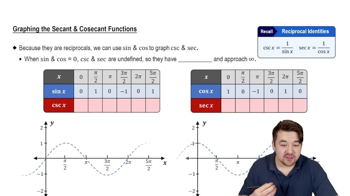Table of contents
- 0. Functions7h 52m
- Introduction to Functions16m
- Piecewise Functions10m
- Properties of Functions9m
- Common Functions1h 8m
- Transformations5m
- Combining Functions27m
- Exponent rules32m
- Exponential Functions28m
- Logarithmic Functions24m
- Properties of Logarithms34m
- Exponential & Logarithmic Equations35m
- Introduction to Trigonometric Functions38m
- Graphs of Trigonometric Functions44m
- Trigonometric Identities47m
- Inverse Trigonometric Functions48m
- 1. Limits and Continuity2h 2m
- 2. Intro to Derivatives1h 33m
- 3. Techniques of Differentiation3h 18m
- 4. Applications of Derivatives2h 38m
- 5. Graphical Applications of Derivatives6h 2m
- 6. Derivatives of Inverse, Exponential, & Logarithmic Functions2h 37m
- 7. Antiderivatives & Indefinite Integrals1h 26m
- 8. Definite Integrals4h 44m
- 9. Graphical Applications of Integrals2h 27m
- 10. Physics Applications of Integrals 2h 22m
3. Techniques of Differentiation
The Chain Rule
Problem 38
Textbook Question
Calculate the derivative of the following functions.
y = csc (t2 + t)
 Verified step by step guidance
Verified step by step guidance1
Step 1: Identify the outer function and the inner function. Here, the outer function is \( \csc(u) \) and the inner function is \( u = t^2 + t \).
Step 2: Differentiate the outer function \( \csc(u) \) with respect to \( u \). The derivative of \( \csc(u) \) is \( -\csc(u)\cot(u) \).
Step 3: Differentiate the inner function \( u = t^2 + t \) with respect to \( t \). The derivative is \( 2t + 1 \).
Step 4: Apply the chain rule. Multiply the derivative of the outer function by the derivative of the inner function: \( \frac{dy}{dt} = -\csc(t^2 + t)\cot(t^2 + t) \cdot (2t + 1) \).
Step 5: Simplify the expression if possible to get the final derivative form.
 Verified video answer for a similar problem:
Verified video answer for a similar problem:This video solution was recommended by our tutors as helpful for the problem above
Video duration:
4mPlay a video:
Was this helpful?
Key Concepts
Here are the essential concepts you must grasp in order to answer the question correctly.
Derivative
The derivative of a function measures how the function's output value changes as its input value changes. It is a fundamental concept in calculus, representing the slope of the tangent line to the curve of the function at any given point. The derivative is denoted as f'(x) or dy/dx, and it can be calculated using various rules such as the power rule, product rule, and chain rule.
Recommended video:

Derivatives
Cosecant Function (csc)
The cosecant function, denoted as csc(x), is the reciprocal of the sine function, defined as csc(x) = 1/sin(x). It is important in calculus for understanding the behavior of trigonometric functions and their derivatives. When differentiating functions involving csc, one must apply the chain rule and the derivative of the sine function, which is crucial for accurate calculations.
Recommended video:

Graphs of Secant and Cosecant Functions
Chain Rule
The chain rule is a fundamental technique in calculus used to differentiate composite functions. It states that if a function y = f(g(x)) is composed of two functions, the derivative can be found by multiplying the derivative of the outer function f with the derivative of the inner function g. This rule is essential when dealing with functions like y = csc(t^2 + t), where the argument of the cosecant function is itself a function of t.
Recommended video:

Intro to the Chain Rule

 5:02m
5:02mWatch next
Master Intro to the Chain Rule with a bite sized video explanation from Callie
Start learningRelated Videos
Related Practice






